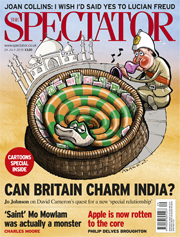 In 1690, Thomas ‘Diamond’ Pitt led an opulent delegation of the
East India Company’s Madras factors, bearing their wares, to the Nawab of the Carnatic, the richest man in southern India, with the intention of buying him out. They succeeded, but Pitt
had nothing on David Cameron’s delegation. Six cabinet ministers, more than 10 CEOs and God knows how many diplomats are accompanying the Prime Minister. The only person missing is Nick
– but that sort of thing is frowned upon by Delhi’s Edwardianly genteel political classes.
In 1690, Thomas ‘Diamond’ Pitt led an opulent delegation of the
East India Company’s Madras factors, bearing their wares, to the Nawab of the Carnatic, the richest man in southern India, with the intention of buying him out. They succeeded, but Pitt
had nothing on David Cameron’s delegation. Six cabinet ministers, more than 10 CEOs and God knows how many diplomats are accompanying the Prime Minister. The only person missing is Nick
– but that sort of thing is frowned upon by Delhi’s Edwardianly genteel political classes.
As I wrote yesterday, pageantry titillates commercial diplomacy, and Cameron is staking everything on this mission. As the Independent reported yesterday, current Anglo-Indian bilateral trade is worth a little more £11bn a year. That is a very small figure. The Indian consumer market is worth £227bn; it is set to rise to £352bn by 2014. The opportunities for Tesco and Arcadia (hell even Milletts) are vast. But it is Wall-Mart’s opportunity too, and America’s trade with India is three times the size of ours.
Cameron will want to open the Indian market on retail, housing and tax; but open markets work both ways, and the Indians are wary of the government’s cap on non-EU migration. Vince Cable intervened today to calm Indian journalists’ concerns. Paul Waugh has the quote, Cable said:
‘So if we are going to attract more foreign investment, foreign companies coming here – whether they’re Indian, Japanese, American, Korean or whatever – then clearly inter-company transfers of people, access to high-level manpower: these have to be respected. This is a point the Indians are making to us, and they’re right to make it. ‘It’s no great secret that in my department and me personally, we want to see an open economy, and as liberal an immigration policy as it’s possible to have. We believe that, because it’s good for growth and good for the British economy.’
Cable is right. India wants greater access to British Higher Education and health care; companies will want skilled labour to move between jurisdictions in a global economy that becomes ever more fluid; in return, India lowers the barriers to its enormous market and extends its already large investments in British firms. Yet, against this, is the non-EU migrant cap – a protectionist measure that privileges the stagnant internal EU market. I’m not the first to note the contradiction between the government’s commercial foreign policy and its populist immigration policy. (Political cowardice is to blame – if you want to stop mass migration from countries that are short on literacy but long in jihad, do so. Don’t try to cheat the market.)
Cameron has one course of action. Jo Johnson wrote in his must read piece for this week’s magazine:
‘New Delhi is certainly open to the prospect of a revitalised relationship with Britain, the question is how effectively Cameron exploits the goodwill.’
If aid is not on the negotiating table, which I understand it isn’t, then immigration must be. And what’s the harm? One good turn deserves another.






Comments